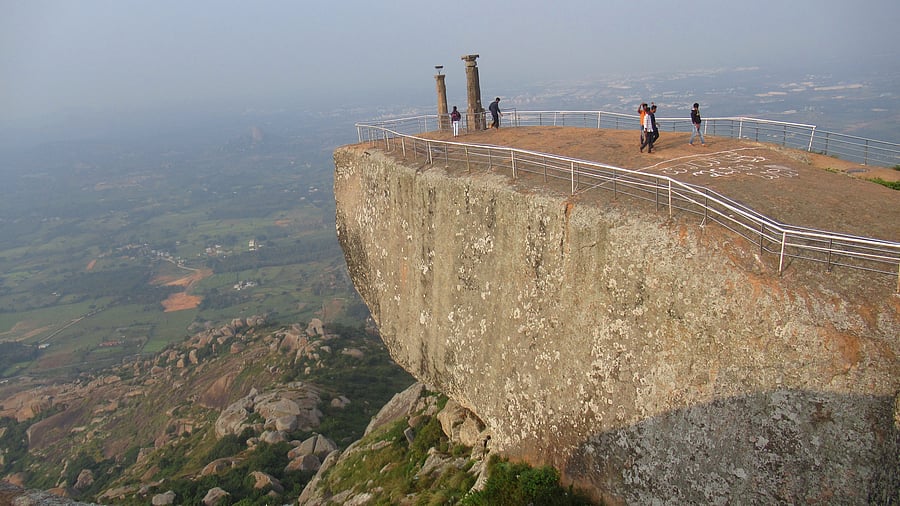
Two stone pillars at the pinnacle of Shivagange hill; (below) a hero stone at Kambalu village.
Credit: Photos by the author
During one of my treks up to the pinnacle of Shivagange hill in Bengaluru Rural district, I was intrigued by two tall stone pillars, standing on the magnificent, outstretched rock. I was told that these two pillars, called ‘dipa stambha’ (lamp pillar) and ‘tirthada kambha’ (sacred water pillar), were carved many centuries ago at the nearby Kambalu village.
It must have been a herculean task to haul such heavy pillars all the way from Kambalu to the peak, especially along the last steep stretch. I remembered having read about a village by the same name in the Mysore Archaeological Survey (MAS) report for the year 1914-15.
The MAS report mentions an ancient Lingayat matha with shrines of Mallikarjuna and Marula Siddeshwara. When I looked at the archives, I found an inscription dated 1721 AD in this village, as per Epigraphia Carnatica Vol 9, 1905 (EC9). Its supplement gives details of another inscription on a brass bell inside the matha.
Taking a bus from Dobbaspet, as I alighted at Kambalu, near Shivagange, I noticed a nandi engraved on a stone pillar, facing the hill.
Finding the inscription
When I enquired about inscriptions, I was advised to visit the ancient Shri Kshetra Surya Simhasana Maha Samsthana Matha, popularly called Kambalu matha. The pin-drop silence inside the complex created a serene atmosphere. Small temples dedicated to Mallikarjuna Swamy, Marula Siddeshwara Swamy, Sidda Lingeshwara and Kambada Mallamma surround the mantap, which has a beautiful nandi at its centre.
Credit: Photos by the author
At Mallikarjuna temple, the linga emerging from the ground had a stone panel, with seven goddesses called ‘Elu Manjamma’. After closely observing each bell, I was able to locate the bell that had the inscription mentioned in the supplement to EC9. The inscription states that it was a ‘gift by Siddegowda’s son Lingegowda to the Kambalu matha’s Marula Siddeshwara temple’.
Next to the nearby government school, I found a stone wall interspersed with slabs, which turned out to be beautiful hero stones. The largest one had three panels, with the lower panel depicting the hero fighting with a spear to protect cows; there are five cows carved behind him. Inside the walled enclosure are the remnants of a temple as well as a ‘konda’, used for filling with hot coals for ritual fire-walking.
Credit: Photos by the author
I met Shanthayya meshtru, a retired school teacher who lives in the area. He related how the inscription on the surface of one of the rocks had gotten erased when a new concrete road came up in the vicinity. Right behind the teacher’s house is an ancient mantap with beautiful carvings on every pillar.
Despite spending the whole day at this tiny village, I was unable to find the link between Kambalu and the twin pillars. It was after my return that I chanced upon a Kannada book titled ‘Kambalu’, written by Siddagangayya Kambalu.
Credit: Photos by the author
The author mentions the manuscript of ‘Gururaja Charitra’, written by 16th-century poet Siddananjesha, which he found in the Bangalore University archives. In Gururaja Charitra, it is mentioned that ‘the urigambha (the fire pillar which MAS refers to as dipa stambha) and the tirthada kambha were commissioned by a devotee from Kambalu. After carving, they were carried up the hill to the very top under the supervision of Kambalu matha’s Yogi Marulasiddha’.
In the urigambha, there is an iron plate to place an oil lamp. Every Makara Sankranti, sacred water gets collected beneath the tirthada kambha. MAS mentions an inscription on the lower portion of this pillar, stating that it was set up as a lamp pillar by one Kusa Basavanna during the reign of the Hoysala king Narasimha I (1141-1173). It also mentions that the tirtha kambha was originally intended to be a lamp pillar. Some references indicated that Marula Siddeswara Swamy lived in the 12th century. It is possible that both stories are true.
As I walked to the bus stop, I realised there must be so much history waiting to be unravelled at many of the tiny villages around this region.